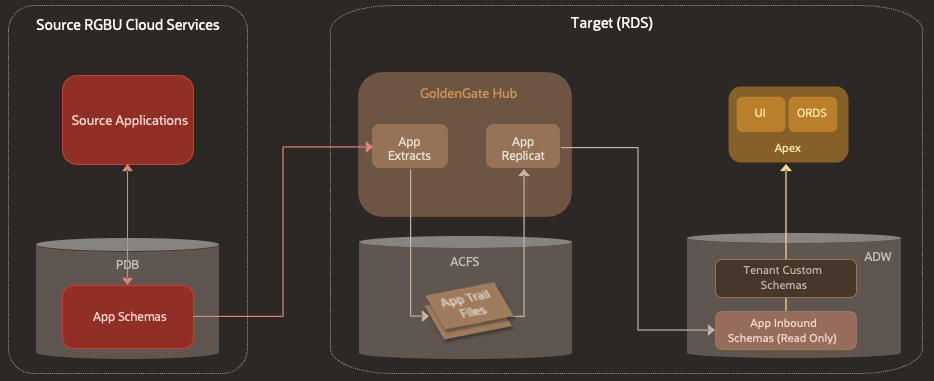1 Implementation Overview
Oracle Retail Data Store (RDS) is a set of infrastructure and tools that allows you to build extensions on top of Retail application data without affecting the original Retail applications. These extensions can consist of database objects, web services, and user interfaces. This Implementation Guide describes the solution and provides information about how you can use RDS.
The core of RDS is a data replication implementation that uses Oracle GoldenGate to replicate application data from Retail applications to a centralized Autonomous Data Warehouse (ADW) database. The data is kept in sync with the source application database in near-real-time.
This data is made available through Oracle REST Data Services (ORDS) and Application Express (APEX) workspaces. When a retailer subscribes to RDS, they are given the URLs and credentials to access these workspaces.
Figure 1-1 Data Replication to RDS via GoldenGate

-
PDB - Pluggable Data Base. The source applications in the RGBU that will be replicating to RDS store their data in pluggable database instances.
-
ACFS - ASM (Automatic Storage Management) Cluster File System. A file system used internally by GoldenGate to store the trail files that hold data replication information.
-
ORDS - Oracle Rest Data Services. An Oracle tool that allows customers to create web services connected directly to data in an Oracle database. RDS customers will use this to create web services to access their custom data.
-
APEX - Application Express. An Oracle tool that allows customers to create UI-based applications connected directly to data in an Oracle database. RDS customers will use this to create appliations that operate on their custom data.
-
ADW - Autonomous Data Warehouse. An Oracle Autonomous Database offering that is tailored toward data warehousing use cases. RDS stores its replicated data and the customer's custom data here.
Separation of Replicated and Custom Data
The replicated application data is held in read-only schemas (one per source application schema). The ORDS and APEX workspaces have access to a read-write schema which can view the read-only schema's database objects. In the read-write schema, you are free to create any database objects you need to create, and you have read privileges to the replicated application data. When new database objects are created in the read-only schema (for example when a patch is applied to the source application), a scheduled database job in the RDS database grants the appropriate read permissions for those objects to the read-write schema. This job runs hourly.
Example
For Merchandising Foundation Cloud Service, an ORDS workspace is available that grants access to the MFCS_RDS_CUSTOM schema. This schema is initially empty, but allows creation of database objects, APEX applications, etc. This schema also has read permissions to database objects in the MFCS_RDS schema, which is where the actual replicated data resides. A customer can use the ORDS workspace to create REST data services that can read the tables with replicated data, or can read and write any custom tables that have been created. A customer can also build APEX applications on top of the custom tables; the read-only replicated tables can be read by the APEX application, but cannot be modified.
Each Retail application controls what data it replicates to the RDS database. Refer to each application's product documentation for details about the data that is made available in RDS.